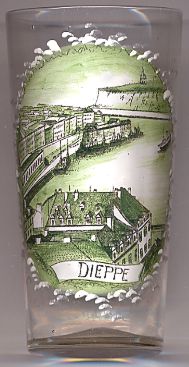

|
| FRANCE | FRANCE |
| région: Normandie | Normandy |
| département: 76, Seine-Maritime |
 Dieppe is located on the Manche (English Channel) coast in the département Seine-Maritime.
Dieppe is the sous-préfecture of the arrondissement Dieppe;
it is also the chef-lieu of two cantons (Dieppe-Est, Dieppe-Ouest). The municipality has apopulation of about 33,600 (2008).
Dieppe is located on the Manche (English Channel) coast in the département Seine-Maritime.
Dieppe is the sous-préfecture of the arrondissement Dieppe;
it is also the chef-lieu of two cantons (Dieppe-Est, Dieppe-Ouest). The municipality has apopulation of about 33,600 (2008).
First mentioned as Deppae in 1015–1029, and Dieppa in 1030, as a small fishing town, Dieppe was an important prize fought over during the Hundred Years' War (1337–1453). Dieppe housed the most advanced French school of cartography in the 16th century, and was the premier port of the kingdom in the 17th century. On 23 July 1632, 300 colonists heading to New France departed from Dieppe. At the Revocation of the Edict of Nantes in 1685, Dieppe lost 3000 of its Huguenot citizens, who fled abroad. Dieppe was an important target in wartime; the town was largely destroyed by an Anglo-Dutch naval bombardment in 1694. Rebuilt after 1696, it was popularised as a seaside resort following the 1824 visit of Charles X's widowed daughter-in-law, princess Caroline of Naples and Sicily. She encouraged the building of the recently-renovated municipal theatre, the Petit-Théâtre (1825), associated particularly with Camille Saint-Saëns. During the later nineteenth century, Dieppe became popular with English artists as a beach resort. Prominent literary figures such as Arthur Symons loved to keep up with the latest fads of avant-garde France here, and during "the season" sometimes stayed for weeks on end. The Dieppe Raid in the Second World War (19 August 1942) became known as a bloody battle, and a costly one for the Allies. The Allies suffered more than 1,400 deaths, 1,946 Canadian soldiers were captured. Dieppe was liberated on September 1, 1944 by soldiers from the 2nd Canadian Infantry Division. Dieppe, New Brunswick (previously Léger Corner) received its present name in 1946, in honour of the Canadian soldiers killed in the Dieppe Raid.
Louis de Broglie (1892–1987), a Nobel Prize-winning physicist, was born in Dieppe. Also born in Dieppe was Saint Antoine Daniel (1601–1648), a Jesuit missionary at Sainte-Marie among the Hurons, and one of the eight Canadian Martyrs.
[Text adapted from http://en.wikipedia.org/wiki/Dieppe,_Seine-Maritime]
![[scale]](lineal.jpg)